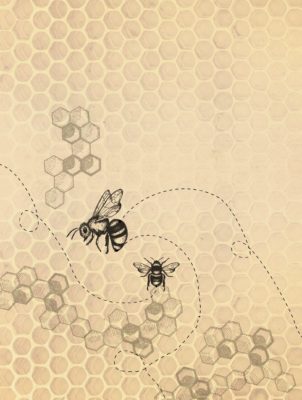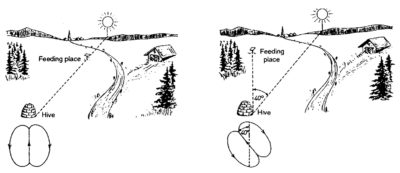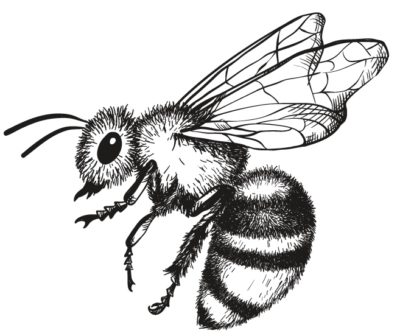“The bee’s life is like a magic well: the more you draw from it, the more it fills with water.”
—Karl von Frisch, Bees: Their Vision, Chemical Senses and Language
 Human beings and honey bees (and a few closely related bee species) are the only animals on Earth that create maps and use symbolic communication to convey spatial information. To do it, both rely on sensors to measure light, gravity, and electromagnetic fields. One comes naturally equipped while the other relies on manufactured items.
Human beings and honey bees (and a few closely related bee species) are the only animals on Earth that create maps and use symbolic communication to convey spatial information. To do it, both rely on sensors to measure light, gravity, and electromagnetic fields. One comes naturally equipped while the other relies on manufactured items.
Perhaps more remarkably, both creatures converged on the same method. They both locate real-world objects in reference to imaginary geometric figures. In other words, they both use datums. Bee datums are the only zoological datums known to exist.
Despite mankind’s long association with honey bees, nobody realized they used datums until Austrian scientist Karl von Frisch published his theory in the 1940’s. Before him, other thinkers as far back as Aristotle had suspected that bees were communicating with each other via their “dances,” but it was he who realized they were using abstract entities, datums, for spatial referencing.
His discovery seized the public imagination. People were astonished by the bee’s complex behavior. They were equally amazed that a man was able to peer into a crowded hive and decipher their movements. As a result of his epiphany, von Frisch gained international fame. His theory was so far ahead of the current scientific thinking that it took many years for it to be completely accepted by his fellow scientists in the emerging field of ethology (animal behaviorism).
In the following paragraph, von Frisch explains how honey bees use datums. This paragraph, and the figures below it, are from his 1973 Nobel Prize acceptance speech. (The prize was shared with fellow ethologists Niko Tinbergen and Konrad Lorenz.) Due to his advanced age—he was 86—the text was delivered by his son, Professor Otto von Frisch.
Those hours at the observation hive when the bees revealed this secret to me remain unforgettable. The fascinating thing is that the angle between the position of the sun and the dancer’s path to the goal is expressed by the dancer in the darkness of the hive, on the vertical surface of the comb, as an angular deflection from the vertical. The bee thus transposes the angle to a different area of sense perception. Figure 3 shows the key to the transposition. If the goal lies in the direction of the sun, the tail-wagging dance points upward. If the goal is located 40º to the left of the sun’s position, the dancer shifts the straight run 40º to the left of the vertical, and so forth. On the comb, members of the hive move after the dancer and maintain close contact with her, especially during the tail-wagging runs, and take in the information offered. Can they follow it and with what accuracy?

Indication of direction by the tail-wagging dance. On the left the dance is pointing at the Sun which happens to be in line with the feeding place. On the right the dance is pointing 40º left of the Sun.
In the figure, the honey bee’s datum is the imaginary line extending from the hive to the sun. Because the sun is always in motion, the datum swings around the hive like a rope attached to a tetherball.
Beekeepers and ethologists refer to the dance as the waggle dance, but sometimes it is called the figure 8 dance due to the path followed by the bee. The straight run between the two loops is called the waggle run. This portion of the dance is essentially a re-enactment of her flight. After the bee finishes a waggle run, she returns to her starting position by alternating between the left and right return loops.
The bee performs her dance on a vertical wax comb inside the dark hive. Her audience crowds in and watches closely. The dancer’s movements cause microscopic deflections in the watchers’ antennae. They register these movements with their Johnston’s organs, a sensitive organ near the base. Such precise communication is vital since the foragers routinely travel three miles from the hive and in times of scarcity will travel as far as six.
Tilt sensors. Like a survey instrument, a honey bee needs to know the direction of gravity to keep precisely oriented in space. To do this, her head is mounted on a pendulum-like neck, which is surrounded by a ring of sensory cells. The feedback from these cells, and from her antennae, provide her with the tilt information she needs.
Occasionally a summer rainstorm keeps a forager trapped in the hive for a few hours. While she’s stuck indoors, the sun continues to circle the horizon at approximately 15 degrees per hour. In two hours, one might expect the azimuth of her dance to be off by 30 degrees. Not to worry. Although it is dark in the hive and she can’t see the sun, she knows where it is and compensates accordingly. The rule is that the “up” direction on the comb always represents the current position of the sun; and so the dancer constantly reorients the figure 8 to keep it properly angled to the ever-rotating reference line. A geodesist would call this a dynamic datum. A honey bee calls it business as usual.
Under a different light, the waggle dance can be interpreted as pair of polar coordinates. Following this analogy, the angular ordinate is given by the orientation of the figure 8, and the radial ordinate (the distance) is given by the duration of the waggle run. The greater the distance—the more time she spends waggling. It varies from hive to hive but the generally accepted equation is that one second of tail waggling equals approximately 750 to 1000 meters of distance.
If you’d like to see a honey bee perform a waggle dance, you can find a video on the internet. Better yet, there’s a good chance you can witness it first-hand. Just go to a county or state fair and find an observation hive. Watch the bees through the clear plastic and look for the characteristic figure 8 pattern.
We underestimate honey bee intelligence. Their neuroplastic brains are densely packed with gray matter and are much larger and more highly structured than other insects. Newcastle University researchers Melissa Bateson and Jeri Wright performed an experiment in which they periodically shook bee hives with a mechanical device. They showed that bees show symptoms of depression and become lethargic when they are overstressed. Do honey bees have emotions? Nobody knows, but the results of their experiment give one pause.
Honey bees have a simple retirement plan: They work themselves to death. One day the worker will leave the hive on a foraging mission and when she tries to return with a full load of nectar, her worn and shredded wings won’t provide the necessary lift. Eventually she will fall to the ground where she will become an easy meal for a passing predator. Thence she will return to her true point of beginning.
Over her lifetime our worker will have collected enough nectar to produce 1/12th of one tablespoon of honey. It doesn’t sound like much, but if they all do their share, she and her sisters will have gathered enough food to sustain the colony through the winter and pass it off to the next generation.
Sidebars:
On-board Compass
 When a bee can’t see the sun or its polarization waves, she resorts to her magnetic compass to determine directions.
When a bee can’t see the sun or its polarization waves, she resorts to her magnetic compass to determine directions.
Here’s what Karl von Frisch had to say about it. This is also from his Nobel acceptance speech.
When a swarm of bees builds its combs in a hive furnished to them by the beekeeper, their position in space is prescribed by the small suspended wooden frames. In the natural habitat of the bee, perhaps in the hollow of a tree, there are no wooden frames present. Nevertheless, thousands of bees labor together and in the course of one night achieve an orderly structure of parallel combs; the individual animal works here and there without getting instructions from a superintendent. They orient themselves by the earth’s magnetic field and uniformly have in mind the comb position which they knew from the parent colony.
Advanced Optics
Using bees, von Frisch was the first to show that animals use polarized vision for navigation.
Here is an excerpt from von Frisch’s Nobel acceptance speech:
Thus, bees are able to perceive polarized light. The sky, which to our eyes is a uniform blue, is distinctly patterned to them (13, 15). They use this extensively and, in their orientation, guide themselves not only by the sun’s position but also by the resulting polarization patterns of the blue sky. They also continue to recognize the sun’s position after it has set or when it is obscured by a mountain. Once again the bees appear to us miraculous. But it is now clear that ants and other insects, crayfish, spiders, and even octopuses perceive polarized light and use it for orientation and that among all these animals the human being is the unendowed one, together with many other vertebrates. In one respect, however, bees remain singular: Only they use polarized light not only for their own orientation but also to communicate to their colonies the direction to a distant goal (6).
In her 2016 biography of Karl von Frisch: The Dancing Bees, Karl von Frisch and the Discovery of the Honeybee Language, author Tania Munz recounts how the founder of the Polaroid Company, Edwin Land, had given Karl von Frisch several sheets of the newly invented polarized foil. Once back in Germany, the ingenious scientist cut the foil into triangles with a pair of scissors and re-assembled the pieces into a model of a compound eye capable of using polarization waves to determine azimuth. Subsequent experiments showed that the model was fundamentally correct.
 Karl von Frisch
Karl von Frisch
It’s notable that much of von Frisch’s work was done under difficult conditions in wartime Germany. Because his maternal grandmother was born into the Jewish faith (and only later converted to Christianity), Nazi party members successfully campaigned to have him removed from his position as the head of zoology at Munich University. Due to the importance of his work and the intervention of his colleagues, this decision was reversed. He also weathered attacks for hiring Jewish and female assistants to work in his lab.
John Hoxeng is the Managing Member of Hoxco Survey, PLLC in Bellingham, Washington. He is a longtime member of the Land Surveyors’ Association of Washington and serves on the Advisory Committee for the Civil and Geomatics Program at Bellingham Technical College. In a former life, John was a juggy on a seismic crew. He figures he’s rolled out enough cable to reach from Bellingham to the Florida Keys.